

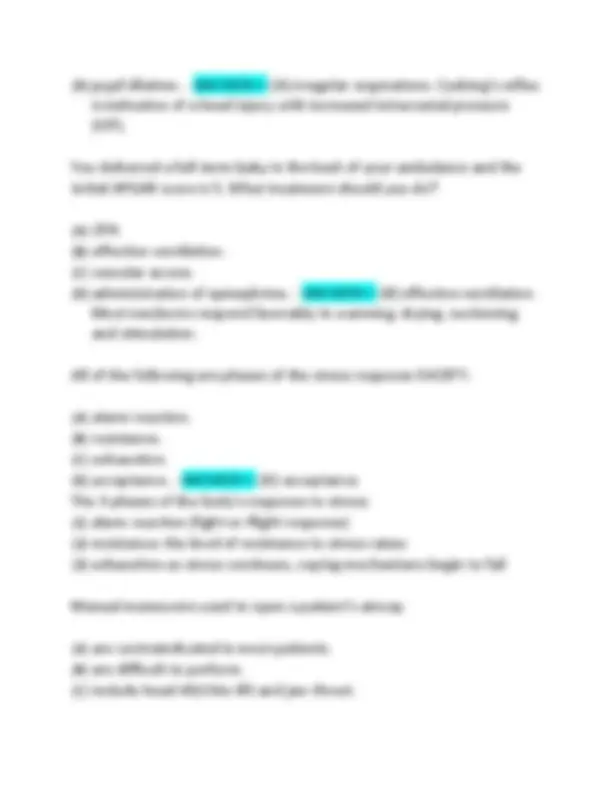
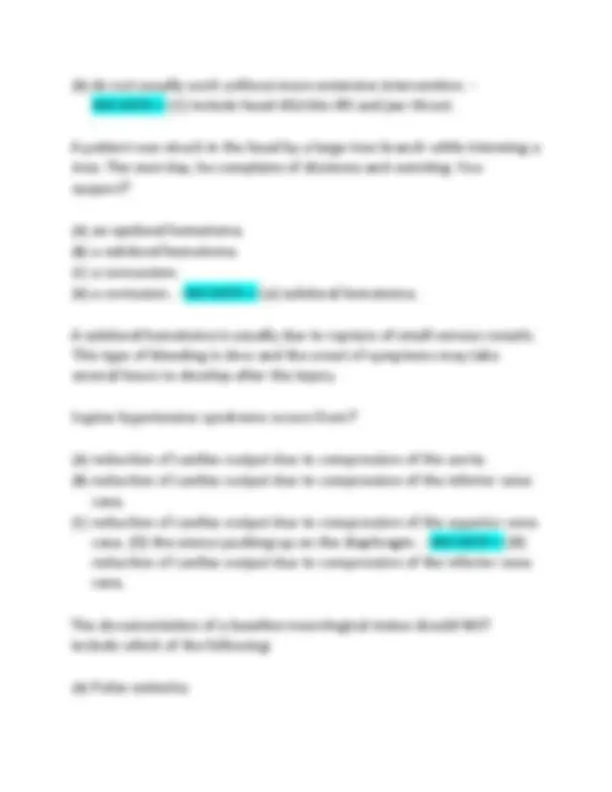
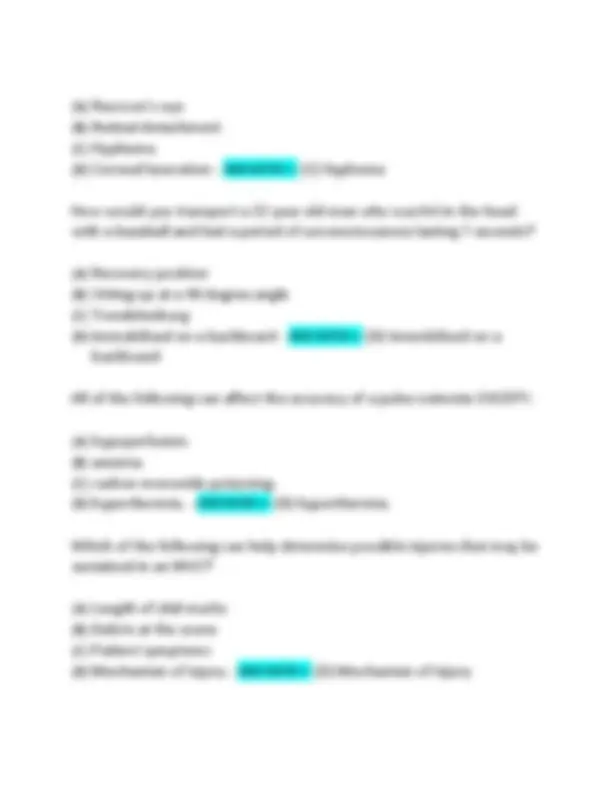
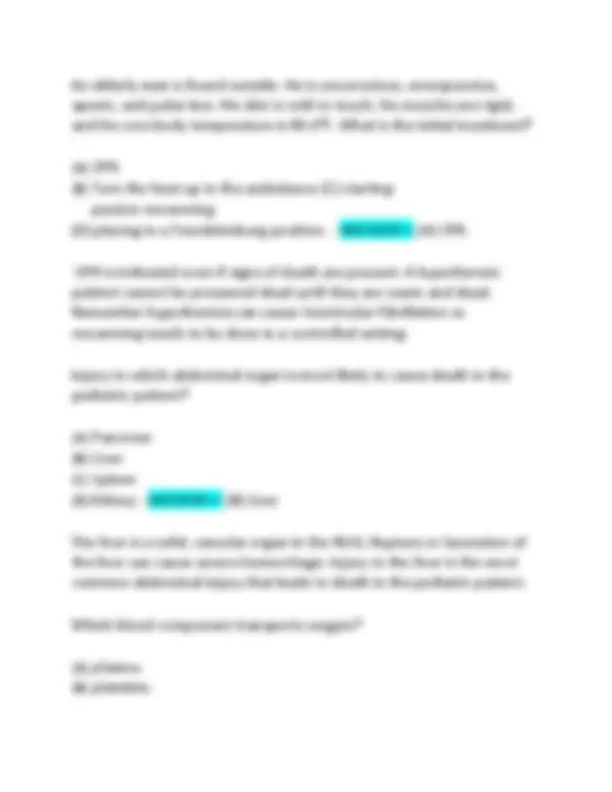
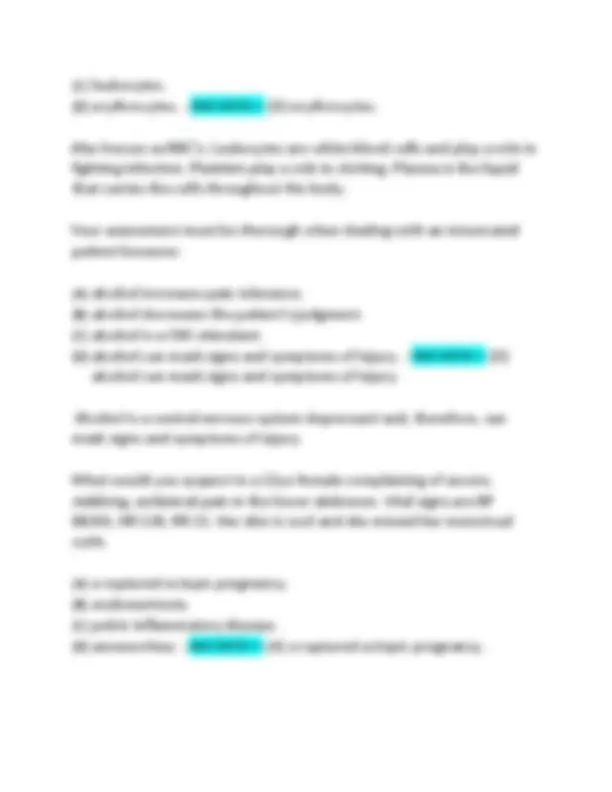
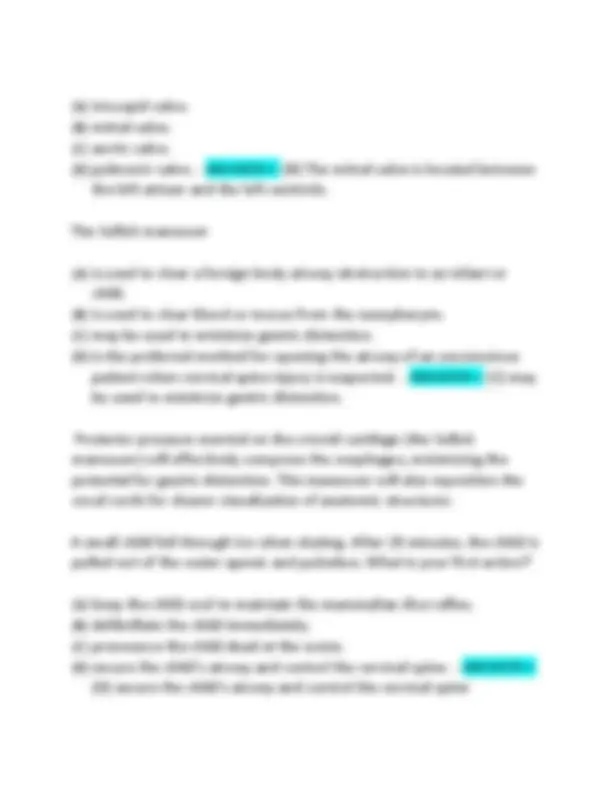
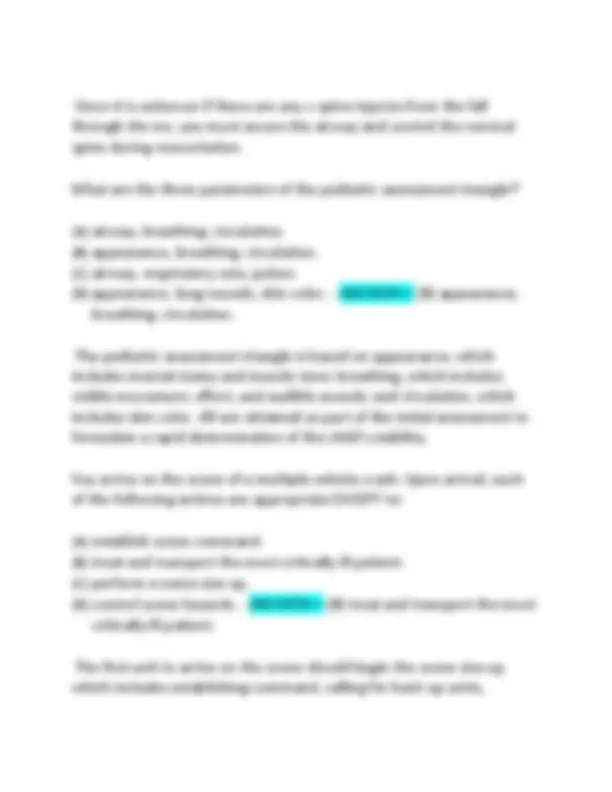
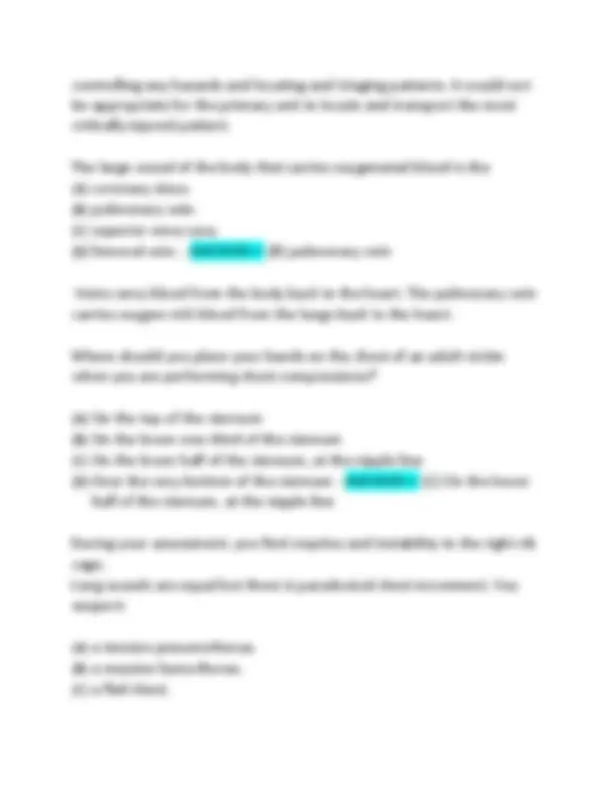
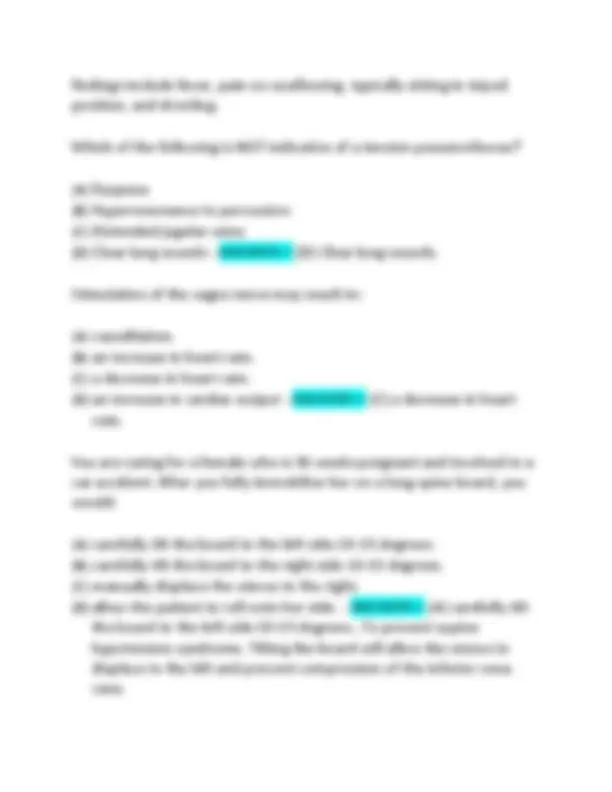
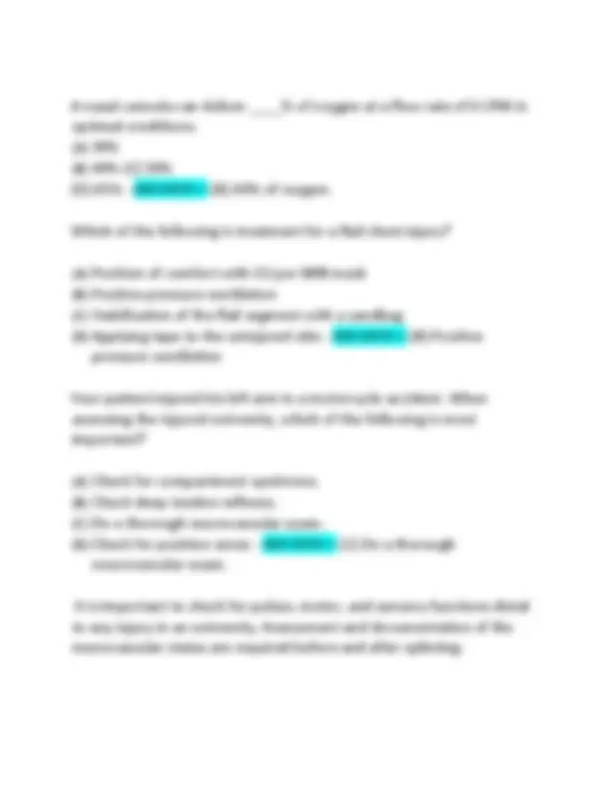
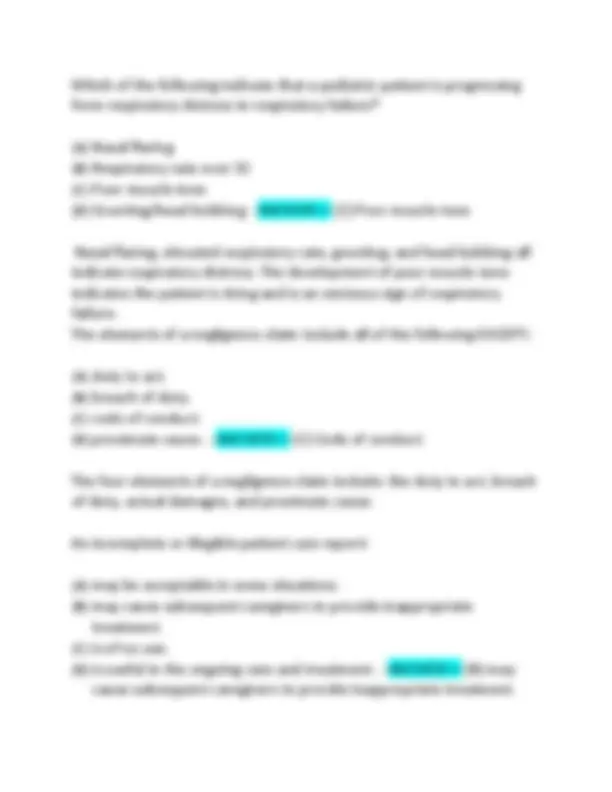
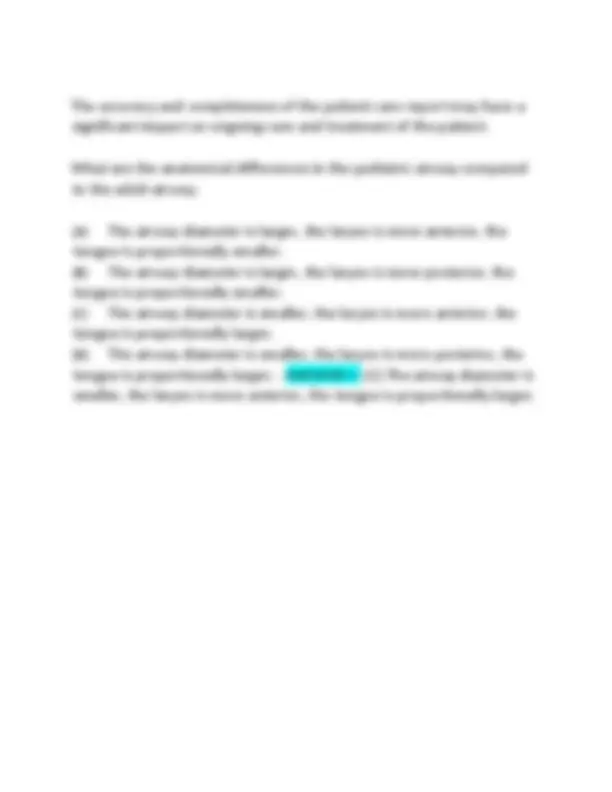


Study with the several resources on Docsity

Earn points by helping other students or get them with a premium plan


Prepare for your exams
Study with the several resources on Docsity

Earn points to download
Earn points by helping other students or get them with a premium plan
Community
Ask the community for help and clear up your study doubts
Discover the best universities in your country according to Docsity users
Free resources
Download our free guides on studying techniques, anxiety management strategies, and thesis advice from Docsity tutors
NREMT EXAM 200 QUESTIONS WITH COMPLETE SOLUTIONS GUARANTEED PASS BRAND NEW 2025
Typology: Exams
1 / 21

This page cannot be seen from the preview
Don't miss anything!














Shaken Baby Syndrome can cause which of the following conditions? (A) Hypoglycemia (B) Abdominal bruising (C) Subdural hematoma (D) Lower extremity fracture - ANSWER>> (C) Subdural hematoma Which law protects an EMT if the EMT acts in good faith, is not negligent, acts within the scope of practice, and does not accept payment for service? (A) implied consent laws. (B) Good Samaritan laws. (C) malfeasance laws. (D) absolute immunity laws. - ANSWER>> (B) Good Samaritan laws You arrive at a two-car accident and the driver of the 1st car is unconscious. Consent for this patient would be? (A) informed. (B) implied. (C) expressed. (D) involuntary. - ANSWER>> (B) implied Organ responsible for insulin production.
(A) adrenal (B) pancreas (C) thyroid (D) thymus - ANSWER>> (B) pancreas Which federal agency regulates telecommunications in the United States? (A) FBI. (B) FDIC. (C) FCC. (D) FACEP. - ANSWER>> (C) FCC. What is the rate of chest compressions for a two-year-old in cardiac arrest? (A) 80/minute. (B) 100/minute. (C) 110/minute. (D) 120/minute. - ANSWER>> (B) 100/minute. A BVM with a reservoir and oxygen source (at least 15 LPM) delivers an oxygen concentration of (A) 21%. (B) 40% to 60%. (C) 80%. (D) 100%. - ANSWER>> (D) 100%. Beck's triad (associated with pericardial tamponade) includes: distant heart tones, JVD, and...
(D) pupil dilation. - ANSWER>> (A) irregular respirations. Cushing's reflex is indicative of a head injury with increased intracranial pressure (ICP). You delivered a full-term baby in the back of your ambulance and the initial APGAR score is 5. What treatment should you do? (A) CPR. (B) effective ventilation. (C) vascular access. (D) administration of epinephrine. - ANSWER>> (B) effective ventilation. Most newborns respond favorably to warming, drying, suctioning, and stimulation. All of the following are phases of the stress response EXCEPT: (A) alarm reaction. (B) resistance. (C) exhaustion. (D) acceptance. - ANSWER>> (D) acceptance. The 3 phases of the body's response to stress: (1) alarm reaction (fight-or-flight response) (2) resistance: the level of resistance to stress raises (3) exhaustion-as stress continues, coping mechanisms begin to fail Manual maneuvers used to open a patient's airway (A) are contraindicated in most patients. (B) are difficult to perform. (C) include head-tilt/chin-lift and jaw thrust.
(D) do not usually work without more extensive intervention. - ANSWER>> (C) include head-tilt/chin-lift and jaw thrust. A patient was struck in the head by a large tree branch while trimming a tree. The next day, he complains of dizziness and vomiting. You suspect? (A) an epidural hematoma. (B) a subdural hematoma. (C) a concussion. (D) a contusion. - ANSWER>> (a) subdural hematoma. A subdural hematoma is usually due to rupture of small venous vessels. This type of bleeding is slow and the onset of symptoms may take several hours to develop after the injury. Supine hypotensive syndrome occurs from? (A) reduction of cardiac output due to compression of the aorta. (B) reduction of cardiac output due to compression of the inferior vena cava. (C) reduction of cardiac output due to compression of the superior vena cava. (D) the uterus pushing up on the diaphragm. - ANSWER>> (B) reduction of cardiac output due to compression of the inferior vena cava. The documentation of a baseline neurological status should NOT include which of the following: (A) Pulse oximetry
(D) has postpartum depression. - ANSWER>> (B) has preeclampsia. Common signs and symptoms of preeclampsia include headache, dizziness, blurred vision, nausea, vomiting, hypertension and edema. Treatment for a patient with preeclampsia would include: (A) rapid transport with lights and siren. (B) administering nitroglycerin to lower the blood pressure. (C) transport for psychiatric evaluation. (D) keeping the patient calm; transport without lights and siren. - ANSWER>> (D) keeping the patient calm; transport without lights and siren. If you suspect preeclampsia, you should take precautions to prevent seizures, which include keeping the patient calm and transporting without lights and sirens. Which of the following statements is true regarding chemical burns? (A) Always use antidotes or neutralizing agents. (B) Acid burns are typically more serious than alkali burns. (C) Both acids and alkalis cause burns by disrupting cell membranes and damaging tissues on contact. (D) Always approach a chemical spill from downwind. - ANSWER>> (C) Both acids and alkalis cause burns by disrupting cell membranes and damaging tissues on contact. When assessing an injured eye, you see a collection of blood in front of the pupil and iris. What is it called?
(A) Raccoon's eye (B) Retinal detachment (C) Hyphema (D) Corneal laceration - ANSWER>> (C) Hyphema How would you transport a 22 year old man who was hit in the head with a baseball and had a period of unconsciousness lasting 7 seconds? (A) Recovery position (B) Sitting up at a 90 degree angle (C) Trendelenburg (D) Immobilized on a backboard - ANSWER>> (D) Immobilized on a backboard All of the following can affect the accuracy of a pulse oximeter EXCEPT: (A) hypoperfusion. (B) anemia. (C) carbon monoxide poisoning. (D) hyperthermia. - ANSWER>> (D) hyperthermia. Which of the following can help determine possible injuries that may be sustained in an MVC? (A) Length of skid marks (B) Debris at the scene (C) Patient symptoms (D) Mechanism of injury - ANSWER>> (D) Mechanism of injury
(C) leukocytes. (D) erythrocytes. - ANSWER>> (D) erythrocytes. Also known as RBC's. Leukocytes are white blood cells and play a role in fighting infection. Platelets play a role in clotting. Plasma is the liquid that carries the cells throughout the body. Your assessment must be thorough when dealing with an intoxicated patient because: (A) alcohol increases pain tolerance. (B) alcohol decreases the patient's judgment. (C) alcohol is a CNS stimulant. (D) alcohol can mask signs and symptoms of injury. - ANSWER>> (D) alcohol can mask signs and symptoms of injury. Alcohol is a central nervous system depressant and, therefore, can mask signs and symptoms of injury. What would you suspect in a 22yo female complaining of severe, stabbing, unilateral pain in the lower abdomen. Vital signs are BP 88/64, HR 128, RR 22. Her skin is cool and she missed her menstrual cycle. (A) a ruptured ectopic pregnancy. (B) endometriosis. (C) pelvic inflammatory disease. (D) amenorrhea. - ANSWER>> (A) a ruptured ectopic pregnancy.
The classic triad of symptom includes abdominal pain, vaginal bleeding, and amenorrhea. Other symptoms include referred pain to the shoulder, nausea, vomiting, or syncope. Signs of shock may be present if the ectopic ruptures. An indicator of severe abdominal trauma after an MVC may include: (A) absent bowel sounds. (B) back pain. (C) referred pain to the clavicle. (D) unexplained shock. - ANSWER>> (D) unexplained shock. When assessment of a trauma patient does not reveal significant injury, the presence of unexplained shock should lead you to suspect serious abdominal/thorax trauma. You arrive on scene to find a 7 y/o boy who is lethargic, cyanotic and has labored breathing. His RR is 50bpm with diminished breath sounds and crackles over the right lung. His temp is 104°F. What do you suspect? (G) cardiogenic shock. (H) a drug overdose. (C) respiratory distress. (D) respiratory failure, probably d/t pneumonia. - ANSWER>> (D) Respiratory failure, most probably due to pneumonia. This is based on tachypnea, increased work of breathing, diminished breath sounds, and elevated temperature.
(A) tricuspid valve. (B) mitral valve. (C) aortic valve. (D) pulmonic valve. - ANSWER>> (B) The mitral valve is located between the left atrium and the left ventricle. The Sellick maneuver (A) is used to clear a foreign body airway obstruction in an infant or child. (B) is used to clear blood or mucus from the nasopharynx. (C) may be used to minimize gastric distention. (D) is the preferred method for opening the airway of an unconscious patient when cervical spine injury is suspected. - ANSWER>> (C) may be used to minimize gastric distention. Posterior pressure exerted on the cricoid cartilage (the Sellick maneuver) will effectively compress the esophagus, minimizing the potential for gastric distention. This maneuver will also reposition the vocal cords for clearer visualization of anatomic structures A small child fell through ice when skating. After 20 minutes, the child is pulled out of the water apneic and pulseless. What is your first action? (A) keep the child cool to maintain the mammalian dive reflex. (B) defibrillate the child immediately. (C) pronounce the child dead at the scene. (D) secure the child's airway and control the cervical spine. - ANSWER>> (D) secure the child's airway and control the cervical spine
Since it is unknown if there are any c-spine injuries from the fall through the ice, you must secure the airway and control the cervical spine during resuscitation. What are the three parameters of the pediatric assessment triangle? (A) airway, breathing, circulation. (B) appearance, breathing, circulation. (C) airway, respiratory rate, pulses. (D) appearance, lung sounds, skin color. - ANSWER>> (B) appearance, breathing, circulation. The pediatric assessment triangle is based on appearance, which includes mental status and muscle tone; breathing, which includes visible movement, effort, and audible sounds; and circulation, which includes skin color. All are obtained as part of the initial assessment to formulate a rapid determination of the child's stability. You arrive on the scene of a multiple vehicle crash. Upon arrival, each of the following actions are appropriate EXCEPT to: (A) establish scene command. (B) treat and transport the most critically ill patient. (C) perform a scene size up. (D) control scene hazards. - ANSWER>> (B) treat and transport the most critically ill patient. The first unit to arrive on the scene should begin the scene size up which includes establishing command, calling for back-up units,
(D) an abdominal aneurysm. - ANSWER>> (C) a flail chest Flail chest is defined as three or more adjacent ribs that are fractured in two or more places. This segment of the chest is free to move with the pressure changes of respirations. A high-pitched noise associated with upper airway constriction is known as (A) wheezes. (B) rhonchi. (C) stridor. (D) rales. - ANSWER>> (C) Stridor Stridor is defined as a high-pitched sound associated caused by obstruction in the trachea or larynx. Which statement correctly relates to pediatric seizures? (A) Febrile seizures typically occur on the 1st day of a febrile illness and have tonic-clonic activity. (B) Always suspect a fever to be the cause of a seizure if the temperature is more than 101°F. (C) Infants and children between the ages of 4 months and 8 years commonly suffer from febrile seizures. (D) Febrile seizures do not require transport if the patient can be cooled. - ANSWER>> (A) Febrile seizures typically occur on the 1st day of a febrile illness and have tonic-clonic activity.
A patient was burned and has blisters to the chest, abdomen, entire right arm, and front of the right leg. According to the rule of nines, what is the percent of burns? (A) 40.5% (B) 36% (C) 45% (D) 31.5% - ANSWER>> (B) 36% (chest = 9%, abdomen = 9%, entire arm 9%, front of the leg = 9%) When using the rule of nines for calculating burns, which of the following is a correct modification for a child? (A) The front of each arm for a child is 7% compared to 9% for an adult. (B) The front of each leg for a child is 4% compared to 9% on an adult. (C) The head of a child is 18% compared to 9% on an adult. (D) The entire leg of a child is 9% compared to 18% on an adult. - ANSWER>> (C) The head of a child is 18% compared to 9% on an adult. You arrive to find a 6 year old child who is in the tripod position and drooling. The child has a fever and difficulty swallowing. What do you suspect? (A) bronchiolitis. (B) croup. (C) epiglottitis. (D) meningitis. - ANSWER>> (C) Epiglottitis Epiglottitis is a bacterial infection causing the acute swelling of the epiglottis and the soft tissues above the glottic opening. Clinical
A nasal cannula can deliver ____% of oxygen at a flow rate of 6 LPM in optimal conditions. (A) 30% (B) 40% (C) 50% (D) 65% - ANSWER>> (B) 40% of oxygen. Which of the following is treatment for a flail chest injury? (A) Position of comfort with O2 per NRB mask (B) Positive pressure ventilation (C) Stabilization of the flail segment with a sandbag (D) Applying tape to the uninjured side - ANSWER>> (B) Positive pressure ventilation Your patient injured his left arm in a motorcycle accident. When assessing the injured extremity, which of the following is most important? (A) Check for compartment syndrome. (B) Check deep tendon reflexes. (C) Do a thorough neurovascular exam. (D) Check for position sense - ANSWER>> (C) Do a thorough neurovascular exam. It is important to check for pulses, motor, and sensory functions distal to any injury in an extremity. Assessment and documentation of the neurovascular status are required before and after splinting.
Which of the following indicate that a pediatric patient is progressing from respiratory distress to respiratory failure? (A) Nasal flaring (B) Respiratory rate over 32 (C) Poor muscle tone (D) Grunting/head bobbing - ANSWER>> (C) Poor muscle tone Nasal flaring, elevated respiratory rate, grunting, and head bobbing all indicate respiratory distress. The development of poor muscle tone indicates the patient is tiring and is an ominous sign of respiratory failure. The elements of a negligence claim include all of the following EXCEPT: (A) duty to act. (B) breach of duty. (C) code of conduct. (D) proximate cause. - ANSWER>> (C) Code of conduct. The four elements of a negligence claim include: the duty to act, breach of duty, actual damages, and proximate cause. An incomplete or illegible patient care report: (A) may be acceptable in some situations. (B) may cause subsequent caregivers to provide inappropriate treatment. (C) is of no use. (D) is useful in the ongoing care and treatment. - ANSWER>> (B) may cause subsequent caregivers to provide inappropriate treatment.